日本では一般的な績み方。つなぎ目が比較的目立たない。
[2+1]method
The most popular method in Japan. The joint part is comparatively smooth.
*宮古では経糸を繋げる時の方法。
In Miyako(Okinawa) they use this method for making warp threads.
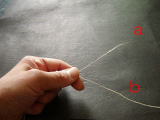

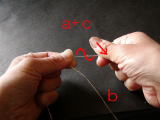
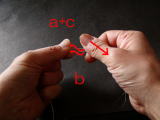
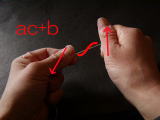
Split the tip end of a fiber. Hold tight where the split starts. Do not release it until the end of the process.
Hold the base end of the other fiber (c) together with the shorter element (a) of the previously split two strands.
The upper strand (a+c) and the lower one (b) are simultaneously Z twisted.
Reversing the finger action allows them to ply together with an S twist
The left thum moves toward you at the same time.
*左手だけ動かしたり、右手だけを使ったり、地域や個人により、やり方がいろいろある。
Some use only their left hand, while others only with the right hand, depending on the region or indivudual.
太目の糸に有効。つなぎ目から糸端が出ないので、後の作業が楽。藤織りは基本的にはこれを使います。
[2+2] method
This method is used for comparatively thicker fibers like those of wisteria. As there is no loose end, the following process will be easier.
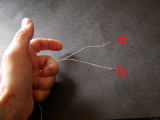
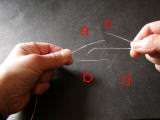
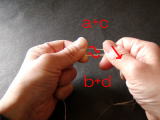
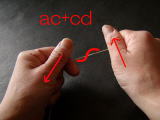
Split the tip end of a fiber into two elements of the same length.
Split the base end of the next fiber.(c & d) Hold tight the start points of the splits of both strands.
Z twist is applied to the two pairs of strands: a and c togather, and b and d together.
Put ac and bd together and apply an S twist.
平たいテープ状の繊維に有効な方法。しな布はこの方法でした。
[slit and 1]method
This method is often used for flat ribbon-like fibers such as linden bark.
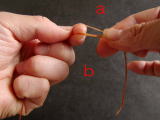
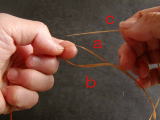
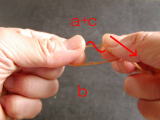
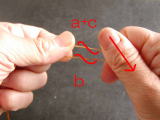
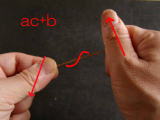
Make a slit in the "tip"end of a fiber.
Hold togather the upper side of the slit (a) and the base end of another fiber (c).
Apply Z twist (a) and (c) together.
Z twist is simultaneously applied to both sides.
Put the two strands together and apply S twist.
韓国の韓山モシ、越後上布などもこの方法で績まれます。
[1+1U-turn] method
This method is used for Hanzan moshi and Echigo joufu,for example.
*宮古島の緯糸用の績み方
aとbを交差させ、aと右の繊維をいっしょにZ撚りをかけ、さらにbにZ撚りをかけてから双方を合わせてS撚りをかける。
Miyakojima method for makong weft yarns:
Cross a and b.
a and the right side of b are Z-twisted together.
b is Z-twisted.
The two strands are S-twisted together.
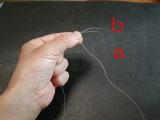
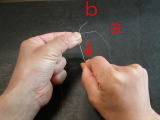
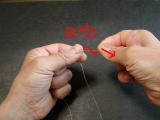
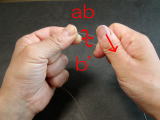
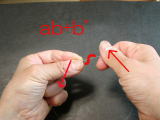
Hold together the "tip" end of a fiber and the "base" end of another one.
Cross (a) and (b) at the point where both become thinner.
Z twist (a) and (b)together and bend the twisted element rightward.
Z twist the rest part of (b) fiber (b').
(ab) and (b') are S twisted together.
Other methods : making warp yarns, etc.
In some regions, for making stronger yarns for warp the loose ends must be tied or intertwisted after these processes above.